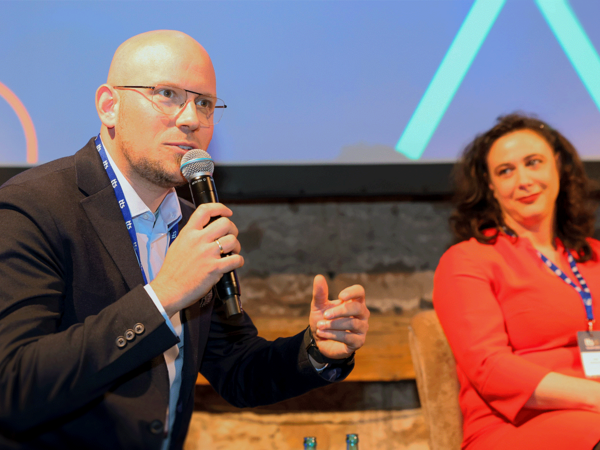"We are different" - a story about the courage of using standards in the public sector

A forge of knowledge with a tradition
Judith Widauer: You say you are different?
Maximilian Petrasko: Yes. We are different - and have been since our founding in 1365; over time, this statement has become our advertising slogan, so to speak. We are different partly because, as a university, we claim to know everything. That is why we have found it so difficult to accept outside advice. It also has to do with our long history. Over the centuries, we have managed all crises on our own.
Now we are surrounded by this wonderful VUCA world. This begs the question: How do we deal with it? We decided to face this change, to open up and allow an outside perspective. In this sense, our project is also the story of how we gained new insights and learned a lot about ourselves.
Judith Widauer: What exactly did you do, and what was the context in which you started?
Jutta Wieltschnig: We implemented SAP SuccessFactors Recruiting. With the new tool, we want to take recruiting to a new level, in part because of the increasingly fierce competition for talent. However, the implementation was anything but trivial because we are different.
For example, our search for qualified specialists is decentralized. We have about 1,200 job postings every year; we can't handle all of them ourselves. As the HR department, we set the quality criteria for the recruitment process and manage the whole thing, but the individual departments take care of the process themselves.
However, there were two other reasons why the implementation was not trivial. Firstly, we are in the process of strengthening our employer brand, and secondly, we have launched a knowledge portal at the same time. The implementation project was embedded in these two initiatives.
Jutta Wieltschnig, Head of People Development, University of Vienna
Basically every organization is different in its own way. The trick is to recognize what that difference is and what needs to be taken into account.
Judith Widauer: What about cloud readiness?
Maximilian Petrasko: We have proven expertise in this area at the university, such as the Faculty of Computer Science and other specialists. That's why some units are already cloud-ready and have already established a concept and a policy for themselves. The trick now is to create a university-wide solution.
Judith Widauer: How did you approach this project?
Maximilian Petrasko: By first engaging them as an external partner. We wanted someone who could look at the matter from an unbiased outside perspective and advise us on how to deal with this difference. Judith, what was your initial experience of the situation?
Judith Widauer: We regularly do global rollouts and are very familiar with the decentralization aspect. The scale at the University of Vienna surprised us. However, it was an exciting environment for us to gather so many stakeholders, to involve them and to exchange ideas with them.
The success factors
- Recognizing and understanding difference
- Cultivate a distinctive culture of communication
- Nominate and engage ambassadors
- Agile approach according to the Test Driven Development methodology
Maximilian Petrasko: The key to success was actually to create communication spaces from the very beginning and to communicate and coordinate closely and intensively with all departments involved in recruiting - especially with the numerous committees, including the Equal Opportunities Working Group, the Works Council, the individual Dean's offices, the Academic Works Council, etc.
To this end, we selected ambassadors who were convinced of the cause, but we also invited critical voices to join the project team. In this way, we were also able to include personalities who were conscious of their leadership role.
Our agile approach proved to be a wise choice. Using this methodology, known as Test Driven Development, we systematically tested how the new tool interacted with our applications, such as Jira, Confluence, and the entire tool stack.
Jutta Wieltschnig: All these success factors contributed to the fact that we were able to go live at the end of May this year. In my opinion, the decisive factor was that we met regularly and exchanged ideas, as well as having many one-on-one meetings. We made a conscious effort to do this because we had implemented SAP HCM the previous year and had learned from that experience, especially in terms of involvement and communication.
Specifically, we chose a classic approach with a steering and sounding board. On average, the extended project team consisted of 50 people. The exact number depended on the area. There are a lot of legal specifics to consider, especially when it comes to personnel selection. This sometimes pushed us to our limits: Can standard software handle this complexity?
Judith Widauer, Managing Director & Regional Head tts Austria
Our goal was to deliver a good product that works and meets the needs, and with those constraints it was a real challenge and I am proud that we overcame it.
Maximilian Petrasko: Tension also arose from the different expectations. On the one hand, the expectations of the university members with their seven Scrum teams, who also developed the old system, and on the other hand, the limited possibilities of the standard software. Dealing with this delta was not easy. But even though it was hard work at times, we always had suggestions and developed the process iteratively together.
Judith Widauer: The real challenge was that we had a fixed budget, the cloud solution, and a standard product; we had to work with that. Our goal was to deliver a good product that works and meets the needs, and with those constraints it was a real challenge and I am proud that we overcame it.
Jutta Wieltschnig: Yes, we can say that we got the most out of the solution. I would like to take this opportunity to thank the tts team, whose creativity made this possible.
Now that the rollout and the successful information events are over, it's full steam ahead for us to operate the system successfully.
Maximilian Petrasko: Yes, our joint project has come to an end, but the real work begins now and there is still a long way to go before everything is up and running.
Security and digital accessibility are issues that are particularly important to us. We have to ensure the latter in accordance with the Web Accessibility Act. In terms of security, we also have some major technical hurdles to overcome when it comes to interfaces with our other systems, such as HCM. I think privacy is a little less problematic. If, like us, you work with a checklist, inform the relevant committees and involve the data protection officer, you are on the safe side.
Judith Widauer: What is your conclusion?
Jutta Wieltschnig: We're happy that most people in our department now support the new tool, otherwise we wouldn't be able to get it into the organization. The fact that we are different was a challenge, but basically every organization is different in its own way. The trick is to recognize what that difference is and what needs to be taken into account.
Maximilian Petrasko: Yes, recognizing and understanding that difference was the key. For us, the courage to bring someone from the outside on board was crucial.




